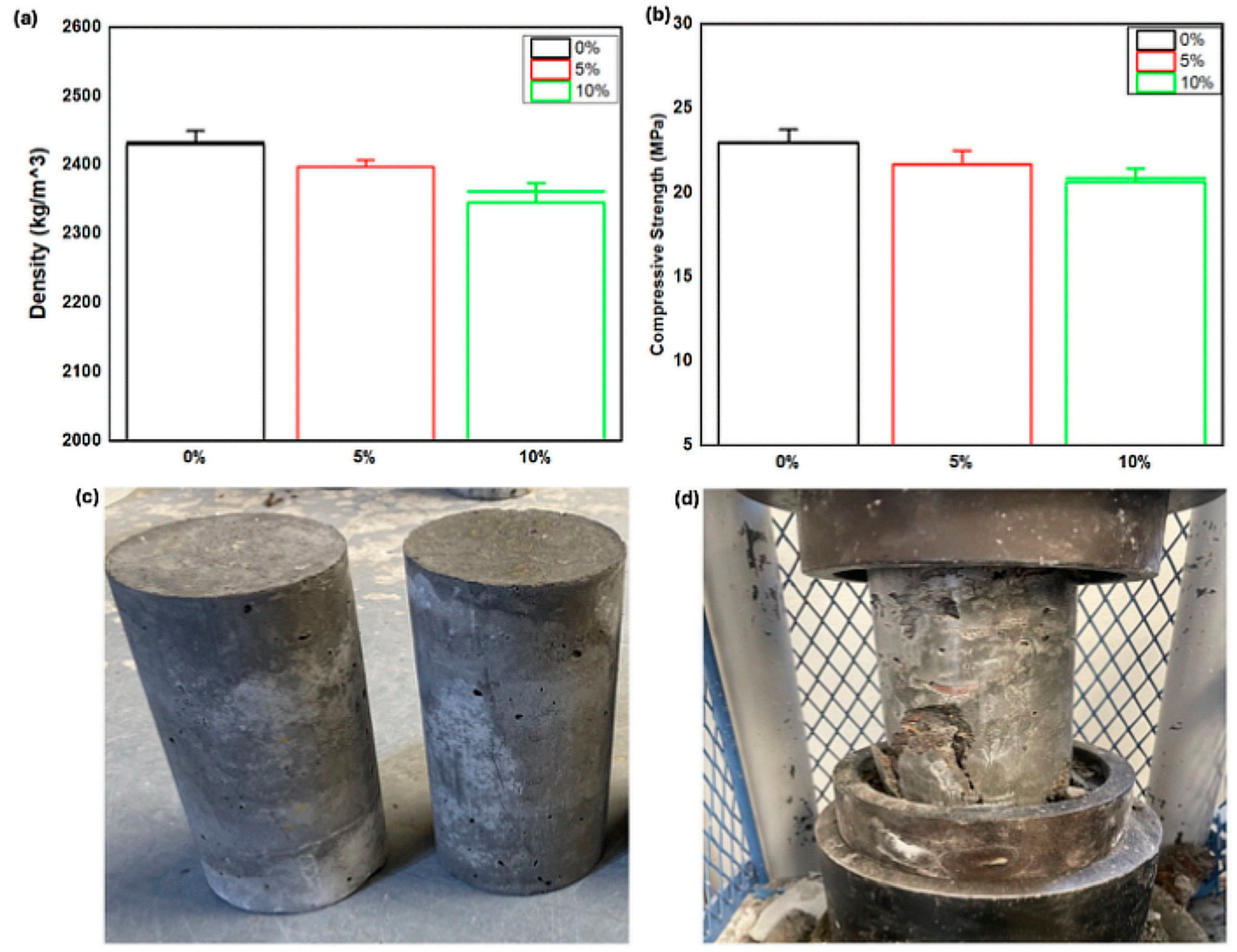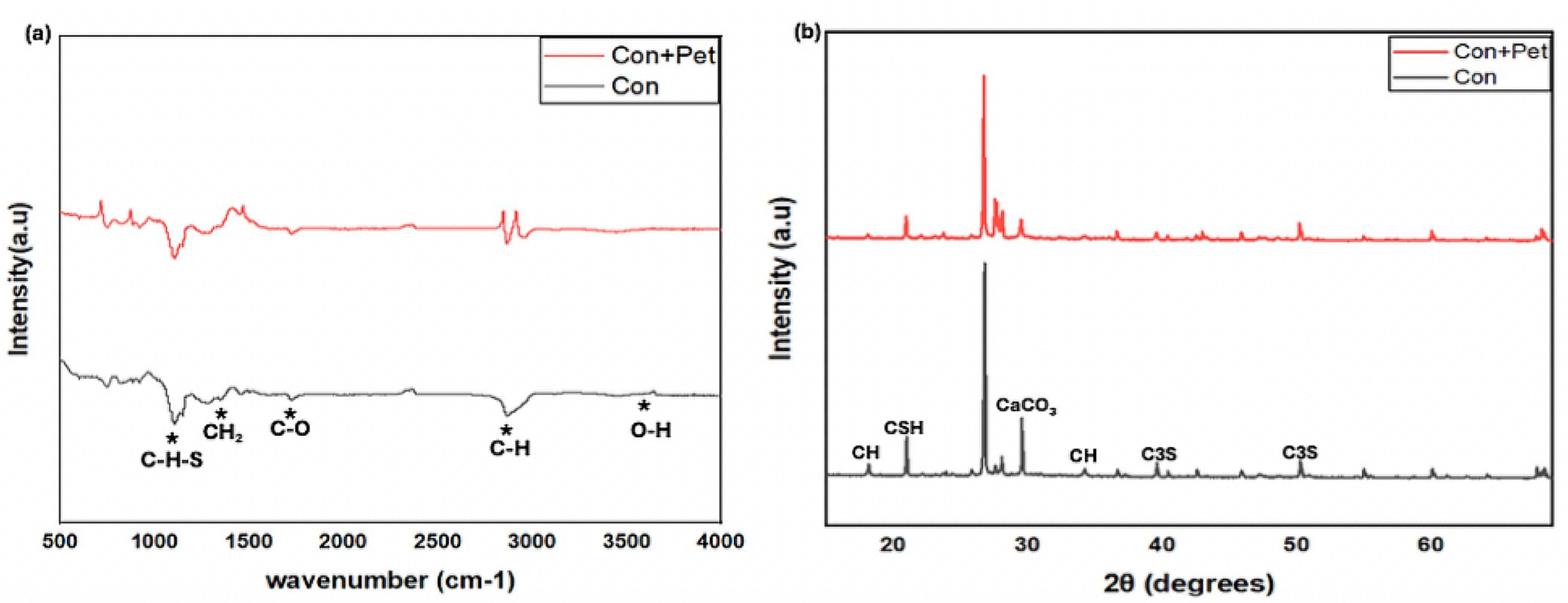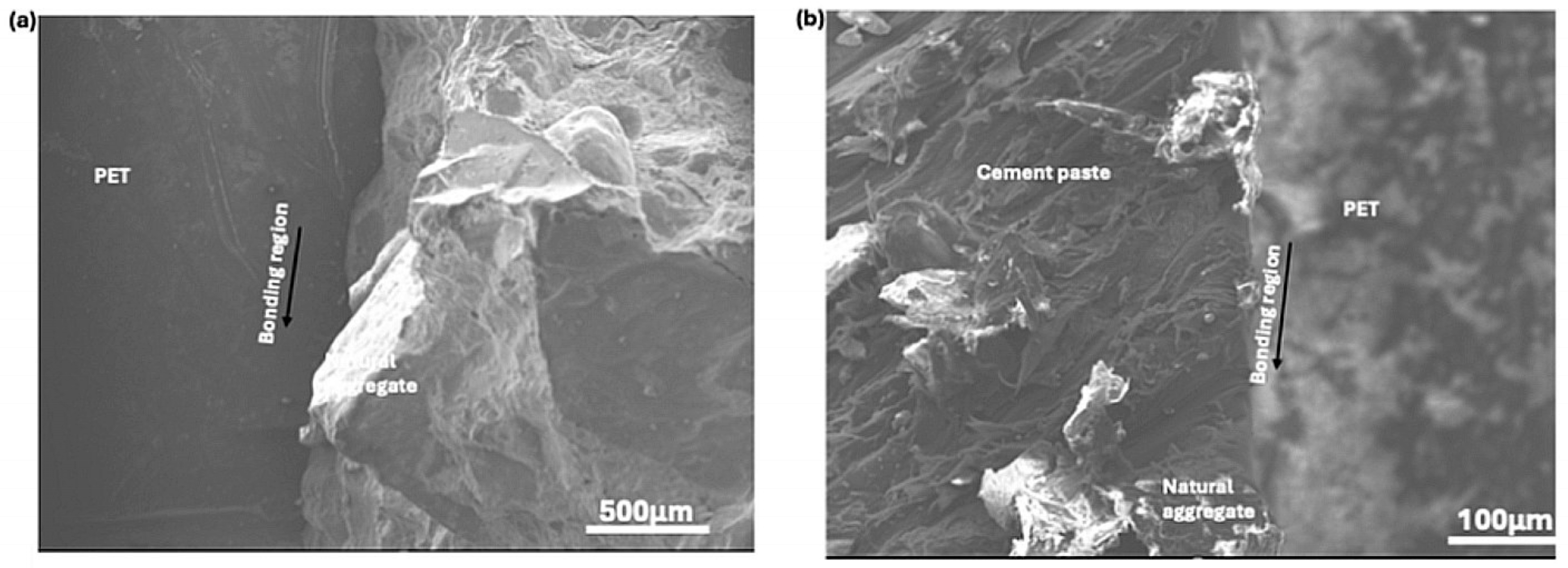Waste Polyethylene Terephthalate (PET) as a Partial Replacement of Aggregates in Sustainable Concrete
Abstract
:1. Introduction
2. Materials and Methods
2.1. PET Waste Aggregate Preparation
2.2. Concrete Sample Preparation with Waste PET
2.3. Compressive Strength Test
2.4. Phase Analysis
2.5. Microstructural Analysis with Field Emission Scanning Electron Microscopy (FESEM)
3. Results
4. Discussion
4.1. Compressive Strength Because of PET Incorporation in Concrete
4.2. Enhancing the Bonding Between PET and Concrete and Phase Analysis
4.3. PET Reinforced Concrete as a Novel and Sustainable Construction Material
5. Conclusions
Author Contributions
Funding
Data Availability Statement
Acknowledgments
Conflicts of Interest
References
- Abubakar, L.; Jain, S.; Ahlen, I.; Bhattacharjee, A. Turmeric-coated sustainable concrete with antibacterial properties. MRS Commun. 2024, 14, 957–963. [Google Scholar] [CrossRef]
- Gagg, C.R. Cement and concrete as an engineering material: An historic appraisal and case study analysis. Fail. Anal. 2014, 40, 114–140. [Google Scholar] [CrossRef]
- Kim, T.H.; Chae, C.U. Environmental impact analysis of acidification and eutrophication due to emissions from the production of concrete. Sustainability 2016, 8, 578. [Google Scholar] [CrossRef]
- Behera, M.; Bhattacharyya, S.K.; Minocha, A.K.; Deoliya, R.; Maiti, S. Recycled aggregate from C&D waste & its use in concrete—A breakthrough towards sustainability in construction sector: A review. Constr. Build. Mater. 2014, 68, 501–516. [Google Scholar] [CrossRef]
- Nilimaa, J.; Zhaka, V. Material and Environmental Aspects of Concrete Flooring in Cold Climate. Constr. Mater. 2023, 3, 180–201. [Google Scholar] [CrossRef]
- Tassos, C.; Sideris, K.K.; Chatzopoulos, A.; Tzanis, E.; Katsiotis, M.S. Influence of the Type of Cement on the Durability of Concrete Structures Exposed to Various Carbonation Environments in Greece: A Contribution to the Sustainability of Structures. Constr. Mater. 2023, 3, 14–35. [Google Scholar] [CrossRef]
- Almohana, A.I.; Abdulwahid, M.Y.; Galobardes, I.; Mushtaq, J.; Almojil, S.F. Producing sustainable concrete with plastic waste: A review. Environ. Chall. 2022, 9, 100626. [Google Scholar] [CrossRef]
- Mohamad, N.; Muthusamy, K.; Embong, R.; Kusbiantoro, A.; Hashim, M.H. Environmental impact of cement production and Solutions: A review. Mater. Today Proc. 2021, 48, 741–746. [Google Scholar] [CrossRef]
- Muda, M.M.; Legese, A.M.; Urgessa, G.; Boja, T. Strength, Porosity and Permeability Properties of Porous Concrete Made from Recycled Concrete Aggregates. Constr. Mater. 2023, 3, 81–92. [Google Scholar] [CrossRef]
- Assi, L.; Carter, K.; Deaver, E.; Anay, R.; Ziehl, P. Sustainable concrete: Building a greener future. J. Clean. Prod. 2018, 198, 1641–1651. [Google Scholar] [CrossRef]
- Abb, C.; Ali, S.H. Building Materials and the Climate: Constructing a New Future; United Nations Environment Programme: Nairobi, Kenya, 2023. [Google Scholar]
- Swain, S.N.; Biswal, S.M.; Nanda, P.K.; Nayak, P.L. Biodegradable Soy-Based Plastics: Opportunities and Challenges. J. Polym. Environ. 2004, 12, 35–42. [Google Scholar] [CrossRef]
- Nayanathara Thathsarani Pilapitiya, P.G.C.; Ratnayake, A.S. The world of plastic waste: A review. Clean. Mater. 2024, 11, 100220. [Google Scholar] [CrossRef]
- Shams, M.; Alam, I.; Mahbub, M.S. Plastic Pollution During COVID-19: Plastic Waste Directives and Its Long-term Impact on The Environment. Environ. Adv. 2021, 5, 100119. [Google Scholar] [CrossRef]
- Rahmani, E.; Dehestani, M.; Beygi, M.H.A.; Allahyari, H.; Nikbin, I.M. On the mechanical properties of concrete containing waste PET particles. Constr. Build. Mater. 2013, 47, 1302–1308. [Google Scholar] [CrossRef]
- Belmokaddem, M.; Mahi, A.; Senhadji, Y.; Pekmezci, B.Y. Mechanical and physical properties and morphology of concrete containing plastic waste as aggregate. Constr. Build. Mater. 2020, 257, 119559. [Google Scholar] [CrossRef]
- Al Mamun, A.; Prasetya, T.A.E.; Dewi, I.R.; Ahmad, M. Microplastics in human food chains: Food becoming a threat to health safety. Sci. Total Environ. 2023, 858, 159834. [Google Scholar] [CrossRef] [PubMed]
- Sharma, A.; Aloysius, V.; Visvanathan, C. Recovery of plastics from dumpsites and landfills to prevent marine plastic pollution in Thailand. Waste Dispos. Sustain. Energy 2019, 1, 237–249. [Google Scholar] [CrossRef]
- Clavier, K.A.; Paris, J.M.; Ferraro, C.C.; Townsend, T.G. Opportunities and challenges associated with using municipal waste incineration ash as a raw ingredient in cement production—A review. Resour. Conserv. Recycl. 2020, 160, 104888. [Google Scholar] [CrossRef]
- Ige, O.E.; Olanrewaju, O.A.; Duffy, K.J.; Obiora, C. A review of the effectiveness of Life Cycle Assessment for gauging environmental impacts from cement production. J. Clean. Prod. 2021, 324, 129213. [Google Scholar] [CrossRef]
- Pathak, G.; Nichter, M.; Hardon, A.; Moyer, E.; Latkar, A.; Simbaya, J.; Pakasi, D.; Taqueban, E.; Love, J. Plastic pollution and the open burning of plastic wastes. Glob. Environ. Change 2023, 80, 102648. [Google Scholar] [CrossRef]
- Faraj, R.H.; Mohammed, A.A.; Omer, K.M. Microstructure characteristics, stress–strain behaviour, fresh properties, and mechanical performance of recycled plastic aggregate self-compacting concrete modified with nano-silica. Constr. Build. Mater. 2023, 383, 131371. [Google Scholar] [CrossRef]
- Hamada, H.M.; Al-Attar, A.; Abed, F.; Beddu, S.; Humada, A.M.; Majdi, A.; Yousif, S.T.; Thomas, B.S. Enhancing sustainability in concrete construction: A comprehensive review of plastic waste as an aggregate material. Sustain. Mater. Technol. 2024, 40, e00877. [Google Scholar] [CrossRef]
- Legese, A.M.; Mitiku, D.; Feyessa, F.F.; Urgessa, G.; Boru, Y.T. Experimental Study on the Suitability of Waste Plastics and Glass as Partial Replacement of Fine Aggregate in Concrete Production. Constr. Mater. 2024, 4, 581–596. [Google Scholar] [CrossRef]
- Andrady, A.L.; Neal, M.A. Applications and societal benefits of plastics. Phil Trans. Royal Soc. B Bio Sci. 2009, 364, 1977–1984. [Google Scholar] [CrossRef]
- Almeshal, I.; Tayeh, B.A.; Alyousef, R.; Alabduljabbar, H.; Mohamed, A.M. Eco-friendly concrete containing recycled plastic as partial replacement for sand. J. Mater. Res. Technol. 2020, 9, 4631–4643. [Google Scholar] [CrossRef]
- Babafemi, A.J.; Šavija, B.; Paul, S.C.; Anggraini, V. Engineering properties of concrete with waste recycled plastic: A review. Sustainability 2018, 10, 3875. [Google Scholar] [CrossRef]
- Roy, D.; Berry, E.; Dempster, M. “If it is not made easy for me, I will just not bother”. A qualitative exploration of the barriers and facilitators to recycling plastics. PLoS ONE 2022, 17, e0267284. [Google Scholar] [CrossRef]
- Dhaka, V.; Singh, S.; Anil, A.G.; Naik, T.S.S.K.; Garg, S.; Samuel, J.; Kumar, M.; Ramamurthy, P.C.; Singh, J. Occurrence, toxicity and remediation of polyethylene terephthalate plastics. A review. Environ. Chem. Lett. 2022, 20, 1777–1800. [Google Scholar] [CrossRef] [PubMed]
- Lena, J.B.; Gonçalves, R.A.; Kharel, S.; Kannan, S.; Verma, C.S.; Pinchi, K.M.; Lim, S.; Lam, Y.M. Elucidating the Effect of Polyethylene Terephthalate Chain Structure on Its Enzymatic Degradation Behavior. ACS Sustain. Chem. Eng. 2023, 11, 13974–13987. [Google Scholar] [CrossRef]
- Qaidi, S.; Al-Kamaki, Y.; Hakeem, I.; Dulaimi, A.F.; Özkılıç, Y.; Sabri, M.; Sergeev, V. Investigation of the physical-mechanical properties and durability of high-strength concrete with recycled PET as a partial replacement for fine aggregates. Front. Mater. 2023, 10, 1101146. [Google Scholar] [CrossRef]
- Kushwaha, A.; Goswami, L.; Singhvi, M.; Kim, B.S. Biodegradation of poly(ethylene terephthalate): Mechanistic insights, advances, and future innovative strategies. Chem. Eng. J. 2023, 457, 141230. [Google Scholar] [CrossRef]
- Basuhi, R.; Bhuwalka, K.; Roth, R.; Olivetti, E.A. Evaluating strategies to increase PET bottle recycling in the United States. J. Ind. Ecol. 2024, 28, 916–927. [Google Scholar] [CrossRef]
- Nordahl, S.L.; Scown, C.D. Recommendations for life-cycle assessment of recyclable plastics in a circular economy. Chem. Sci. 2024, 15, 9397–9407. [Google Scholar] [CrossRef] [PubMed]
- Saikia, N.; De Brito, J. Use of plastic waste as aggregate in cement mortar and concrete preparation: A review. Constr. Build. Mater. 2012, 34, 236–244. [Google Scholar] [CrossRef]
- Askar, M.K.; Al-Kamaki, Y.S.S.; Hassan, A. Utilizing Polyethylene Terephthalate PET in Concrete: A Review. Polymers 2023, 15, 3320. [Google Scholar] [CrossRef] [PubMed]
- Islam, M.J.; Meherier, M.S.; Islam, A.K.M.R. Effects of waste PET as coarse aggregate on the fresh and harden properties of concrete. Constr. Build. Mater. 2016, 125, 946–951. [Google Scholar] [CrossRef]
- Bachtiar, E.; Mustaan; Jumawan, F.; Artayani, M.; Tahang; Rahman, M.J.; Setiawan, A.; Ihsan, M. Examining polyethylene terephthalate (Pet) as artificial coarse aggregates in concrete. Civ. Eng. J. 2020, 6, 2416–2424. [Google Scholar] [CrossRef]
- Supit, S.W.M.; Priyono. Utilization of recycled PET plastic waste as replacement of coarse aggregate in pervious concrete. Mater. Today Proc. 2022, 66, 2990–2995. [Google Scholar] [CrossRef]
- Bahij, S.; Omary, S.; Feugeas, F.; Faqiri, A. Fresh and hardened properties of concrete containing different forms of plastic waste–A review. Was Manag 2020, 113, 157–175. [Google Scholar] [CrossRef]
- Wattanavichien, P.; Iwanami, M. Investigation of the mechanical, microstructure, and durability properties of concrete with fine uniform and non-uniform polyethylene terephthalate (PET) aggregates. Clean. Mater. 2024, 13, 100267. [Google Scholar] [CrossRef]
- Lazorenko, G.; Kasprzhitskii, A.; Fini, E.H. Polyethylene terephthalate (PET) waste plastic as natural aggregate replacement in geopolymer mortar production. J. Clean. Prod. 2022, 375, 134083. [Google Scholar] [CrossRef]
- Saikia, N.; De Brito, J. Mechanical properties and abrasion behaviour of concrete containing shredded PET bottle waste as a partial substitution of natural aggregate. Constr. Build. Mater. 2014, 52, 236–244. [Google Scholar] [CrossRef]
- Kibria, M.G.; Masuk, N.I.; Safayet, R.; Nguyen, H.Q.; Mourshed, M. Plastic Waste: Challenges and Opportunities to Mitigate Pollution and Effective Management. Int. J. Environ. Res. 2023, 17, 20. [Google Scholar] [CrossRef] [PubMed]
- Sharma, M.; Antony, R.; Vadalkar, S.; Ishizaka, A. Role of industry 4.0 technologies and human-machine interaction for de-carbonization of food supply chains. J. Clean. Prod. 2024, 468, 142922. [Google Scholar] [CrossRef]
- da Silva, T.R.; de Azevedo, A.R.G.; Cecchin, D.; Marvila, M.T.; Amran, M.; Fediuk, R.; Vatin, N.; Karelina, M.; Klyuev, S.; Szelag, M. Application of plastic wastes in construction materials: A review using the concept of life-cycle assessment in the context of recent research for future perspectives. Materials 2021, 14, 3549. [Google Scholar] [CrossRef]
- Zulkernain, N.H.; Gani, P.; Chuan, N.C.; Uvarajan, T. Utilisation of plastic waste as aggregate in construction materials: A review. Constr. Build. Mater. 2021, 296, 123669. [Google Scholar] [CrossRef]





| PET Replacement | W/C Ratio | Water (g) | Cement (g) | Fine Aggregate(g) | Coarse Aggregate (g) | PET Aggregate (g) |
|---|---|---|---|---|---|---|
| 0% | 0.49 | 441 | 900 | 1350 | 2700 | 0 |
| 5% | 0.49 | 441 | 900 | 1350 | 2565 | 135 |
| 10% | 0.49 | 441 | 900 | 1350 | 2430 | 270 |
| Percent of Pet Aggregate | Water Cement Ratio | Density (Kg/m3) | 28 Days Compressive Strength (MPa) |
|---|---|---|---|
| 0 | 0.48 | 2429.25 ± 21.25 | 22.99 ± 0.59 |
| 5 | 0.48 | 2397.0 ± 9.13 | 21.68 ± 0.81 |
| 10 | 0.48 | 2345.25 ± 41.71 | 20.62 ± 0.87 |
Disclaimer/Publisher’s Note: The statements, opinions and data contained in all publications are solely those of the individual author(s) and contributor(s) and not of MDPI and/or the editor(s). MDPI and/or the editor(s) disclaim responsibility for any injury to people or property resulting from any ideas, methods, instructions or products referred to in the content. |
© 2024 by the authors. Licensee MDPI, Basel, Switzerland. This article is an open access article distributed under the terms and conditions of the Creative Commons Attribution (CC BY) license (https://creativecommons.org/licenses/by/4.0/).
Share and Cite
Abubakar, L.; Yeasmin, N.; Bhattacharjee, A. Waste Polyethylene Terephthalate (PET) as a Partial Replacement of Aggregates in Sustainable Concrete. Constr. Mater. 2024, 4, 738-747. https://doi.org/10.3390/constrmater4040040
Abubakar L, Yeasmin N, Bhattacharjee A. Waste Polyethylene Terephthalate (PET) as a Partial Replacement of Aggregates in Sustainable Concrete. Construction Materials. 2024; 4(4):738-747. https://doi.org/10.3390/constrmater4040040
Chicago/Turabian StyleAbubakar, Lukman, Nusrat Yeasmin, and Arjak Bhattacharjee. 2024. "Waste Polyethylene Terephthalate (PET) as a Partial Replacement of Aggregates in Sustainable Concrete" Construction Materials 4, no. 4: 738-747. https://doi.org/10.3390/constrmater4040040
APA StyleAbubakar, L., Yeasmin, N., & Bhattacharjee, A. (2024). Waste Polyethylene Terephthalate (PET) as a Partial Replacement of Aggregates in Sustainable Concrete. Construction Materials, 4(4), 738-747. https://doi.org/10.3390/constrmater4040040




